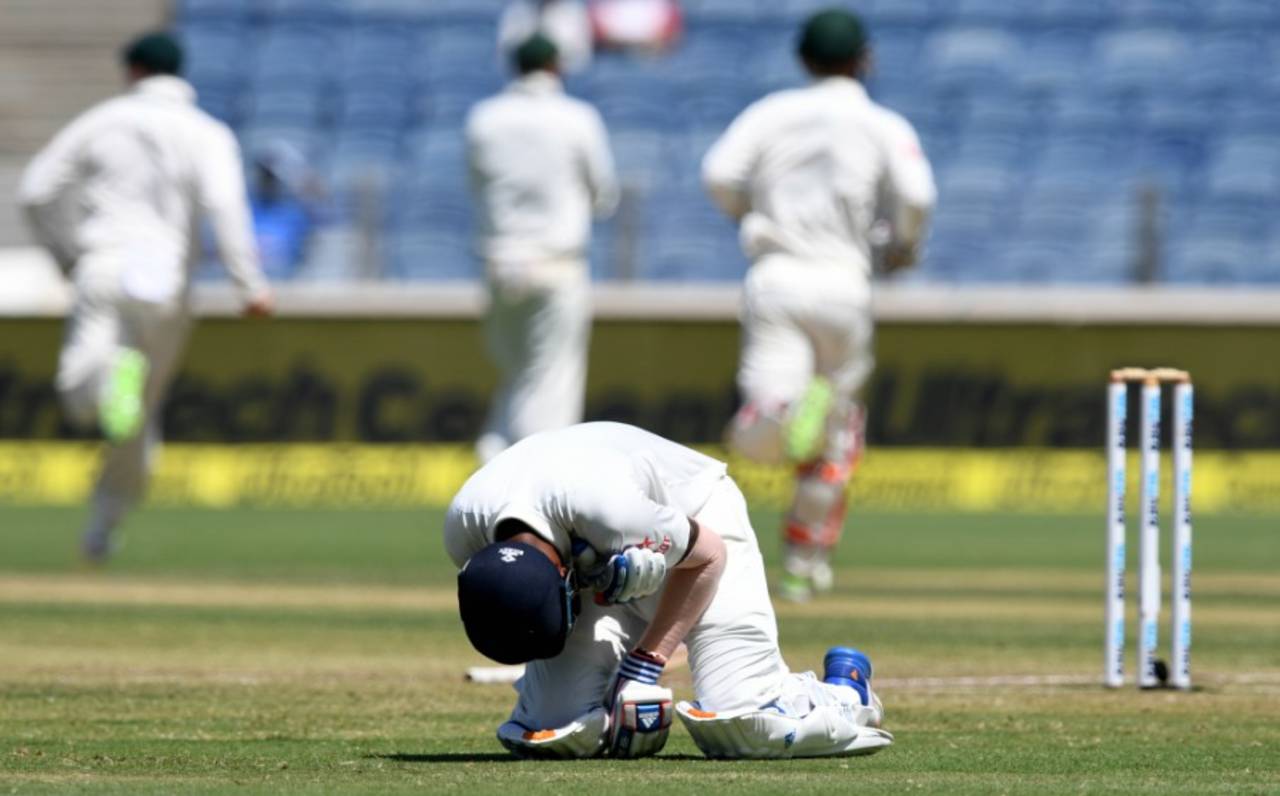32.2 throws it away! And Rahul crumples up, clutching his left shoulder, this looks bad. Awful shot from a batsman who has looked so classy until this very moment. Comes charging out at Australia's weakest bowler and looks to heave him over long-off. But he doesn't quite get the pitch and therefore the shot skews off the outside edge. Warner rushes in from long-off, takes a simple catch and yells his head off in delight 94/4
Unlike descriptions in match reports, ball-by-ball commentary is utterly of the moment and uncoloured by hindsight.
KL Rahul's first-innings dismissal, as we now know, was a key moment in the Pune Test. When it happened, however, Steve O'Keefe
was Australia's weakest bowler, and had just delivered a largely unthreatening spell during the pre-lunch session of day two. From here on, he would be anything but.
It's pointless, but ponder nonetheless an alternate universe in which Rahul did not charge down the pitch and attempt to launch O'Keefe for six.
On Thursday, two days before the start of the second Test at the Chinnaswamy Stadium, his home ground, Rahul was one of a handful of India players who showed up for an optional training session. He spent some 20 minutes facing the quicks at one net, and another 20 facing the spinners in another.
Running in at the fast bowlers' net were Ishant Sharma and
Mohammed Shami - who, bowling mostly off a short run-up, was generating serious pace and seeming to be recovering fast enough from a troublesome right knee and hamstring to be back in contention for the third Test - as well as Dhawal Kulkarni and Barinder Sran, both of whom have been capped by India in ODIs. All four were bowling good-to-full lengths on a fourth-to-fifth-stump line, and Rahul was leaving as many balls as he could.
Jayant Yadav and Kuldeep Yadav, both part of India's Test squad, were bowling at the spinners' net, as was Axar Patel, who has played a handful of ODIs. The pitch seemed deliberately roughed up, to perhaps mimic Pune-like conditions, and Rahul was batting more or less as he'd done in Pune: going after the spinners, sweeping and reverse-sweeping almost every second ball.
Here, it seemed, was a batsman with a clear idea of how he wanted to bat. A batsman aware of a tendency for nerves and looseness at the start of his innings, and aware of the need to give himself time against the new ball, but also a batsman determined to keep playing his shots against spin.
While Rahul's first-innings dismissal in Pune may have looked ugly, there isn't any real argument to suggest he wasn't adopting the right approach through his innings. In a low-scoring match, it brought him 30 runs off 45 balls and a control percentage of 89 against the spinners. To put that in context,
Steven Smith, during his second-innings 109, managed a control percentage of 73 against India's spinners. While scoring his 64, Rahul looked in as much ease as any batsman from either side.
Rahul's ability to sweep and reverse-sweep as well as hit over the top is pretty much unique in India's top five. Some of the others can do one or the other, but not both. It makes him dangerous on turning tracks, where he becomes a key wicket for Australia.
How Bengaluru's pitch will behave remains to be seen. It wore a fine layer of grass on Wednesday, but much of it had disappeared by Thursday afternoon. Australia allrounder Mitchell Marsh said it looked "like a reasonably good wicket" but followed it up by saying it was "pretty dry" and that there were "a few cracks already". India coach Anil Kumble gave equally mixed messages when he said "it's generally been a good batting surface and, yeah, I'm sure it'll be a result wicket".
Given normal batting conditions, Rahul is unlikely to employ his shot-a-ball approach against the spinners. But the way he batted in Pune and during his net session on Thursday suggested India have given him a specific role in case they show up and find themselves on a raging turner. To misuse a baseball term, he becomes their designated hitter.
